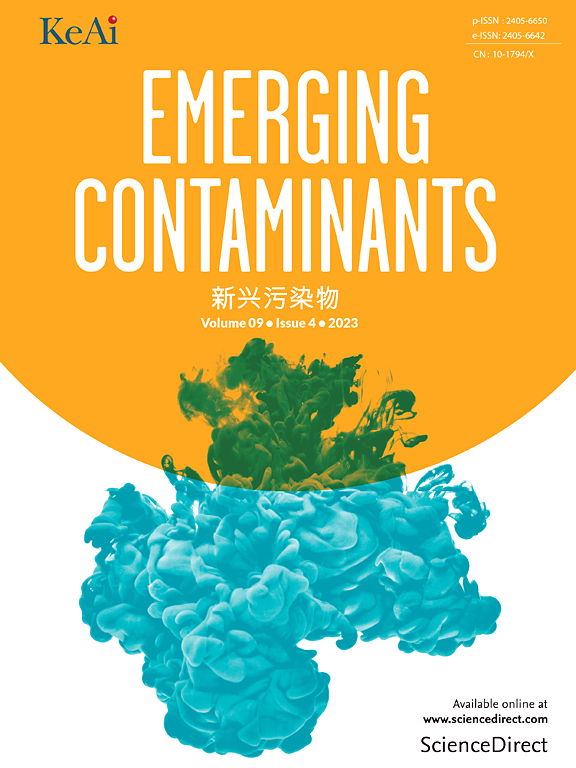PPARα-dependent lipid metabolic disruption mediates triphenyl phosphate–induced hepato- and neurotoxicity in zebrafish
IF 6.9
2区 环境科学与生态学
Q1 ENVIRONMENTAL SCIENCES
引用次数: 0
Abstract
The extensive use of triphenyl phosphate (TPhP) has resulted in its ubiquity in aquatic ecosystems, raising significant concerns about its escalating risks to aquatic organisms. In this study, we employed adult and larval zebrafish (Danio rerio) as model organisms to assess the adverse effects of TPhP exposure on aquatic life. The objectives were to evaluate TPhP-induced hepatotoxicity and neurotoxicity and the role of lipid metabolism in mediating these toxic effects. The results demonstrated that TPhP exposure led to alterations in body weight, length, and body mass index (BMI), along with changes in brain and liver somatic indices in zebrafish. Through comprehensive analyses of histopathological changes, transcriptional profiles, biochemical markers, and neurobehavioral assays, TPhP was shown to induce both morphological and functional impairments in the brain and liver. In TPhP-exposed larvae, reduced tissue integrity and altered spatial distribution of brain and hepatic tissues were observed. Notably, changes in the expression of neurodevelopmental and lipid metabolism-related genes in larvae mirrored those detected in adult zebrafish, indicating conserved toxic mechanisms across life stages. Mechanistically, TPhP exposure induced oxidative stress in both brain and liver tissues and suppressed the expression of PPARα, as well as its downstream genes involved in fatty acid β-oxidation and lipid homeostasis. Consequently, hepatic triglyceride (TG) and total cholesterol (T-CHO) levels were significantly decreased, whereas free fatty acid (FFA) content was elevated. Thus, TPhP inhibits PPARα signaling via oxidative stress, leading to lipid metabolic dysfunction and subsequent damage to neural and hepatic tissues. This study provides robust evidence of TPhP-induced hepatotoxicity and neurotoxicity in zebrafish, and elucidates the critical role of PPARα-mediated disruption of lipid metabolism in these toxic pathways, thereby enhancing our understanding of the ecological risks posed by organophosphate flame retardants.
ppar α依赖的脂质代谢破坏介导三苯基磷酸酯诱导的斑马鱼肝脏和神经毒性
磷酸三苯酯(TPhP)的广泛使用导致其在水生生态系统中无处不在,引起了人们对其对水生生物不断升级的风险的严重关切。在本研究中,我们以斑马鱼(Danio rerio)为模型生物来评估TPhP暴露对水生生物的不良影响。目的是评估tphp诱导的肝毒性和神经毒性以及脂质代谢在介导这些毒性作用中的作用。结果表明,TPhP暴露导致斑马鱼体重、长度和身体质量指数(BMI)的改变,以及大脑和肝脏体细胞指数的变化。通过对组织病理学变化、转录谱、生化标志物和神经行为分析的综合分析,TPhP显示出在脑和肝脏中诱导形态和功能损伤。在暴露于tpp的幼虫中,观察到组织完整性降低,脑和肝组织的空间分布改变。值得注意的是,幼虫中神经发育和脂质代谢相关基因的表达变化与成年斑马鱼中检测到的相同,表明在整个生命阶段中毒性机制是保守的。在机制上,TPhP暴露诱导脑和肝组织氧化应激,抑制PPARα及其下游参与脂肪酸β氧化和脂质稳态的基因的表达。肝脏甘油三酯(TG)和总胆固醇(T-CHO)水平显著降低,游离脂肪酸(FFA)含量升高。因此,TPhP通过氧化应激抑制PPARα信号,导致脂质代谢功能障碍和随后的神经和肝组织损伤。本研究为tpp诱导斑马鱼肝毒性和神经毒性提供了强有力的证据,并阐明了ppar α介导的脂质代谢破坏在这些毒性途径中的关键作用,从而增强了我们对有机磷阻燃剂所带来的生态风险的理解。
本文章由计算机程序翻译,如有差异,请以英文原文为准。
求助全文
约1分钟内获得全文
求助全文
来源期刊

Emerging Contaminants
Medicine-Public Health, Environmental and Occupational Health
CiteScore
10.00
自引率
6.70%
发文量
35
审稿时长
44 days
期刊介绍:
Emerging Contaminants is an outlet for world-leading research addressing problems associated with environmental contamination caused by emerging contaminants and their solutions. Emerging contaminants are defined as chemicals that are not currently (or have been only recently) regulated and about which there exist concerns regarding their impact on human or ecological health. Examples of emerging contaminants include disinfection by-products, pharmaceutical and personal care products, persistent organic chemicals, and mercury etc. as well as their degradation products. We encourage papers addressing science that facilitates greater understanding of the nature, extent, and impacts of the presence of emerging contaminants in the environment; technology that exploits original principles to reduce and control their environmental presence; as well as the development, implementation and efficacy of national and international policies to protect human health and the environment from emerging contaminants.
 求助内容:
求助内容: 应助结果提醒方式:
应助结果提醒方式:


